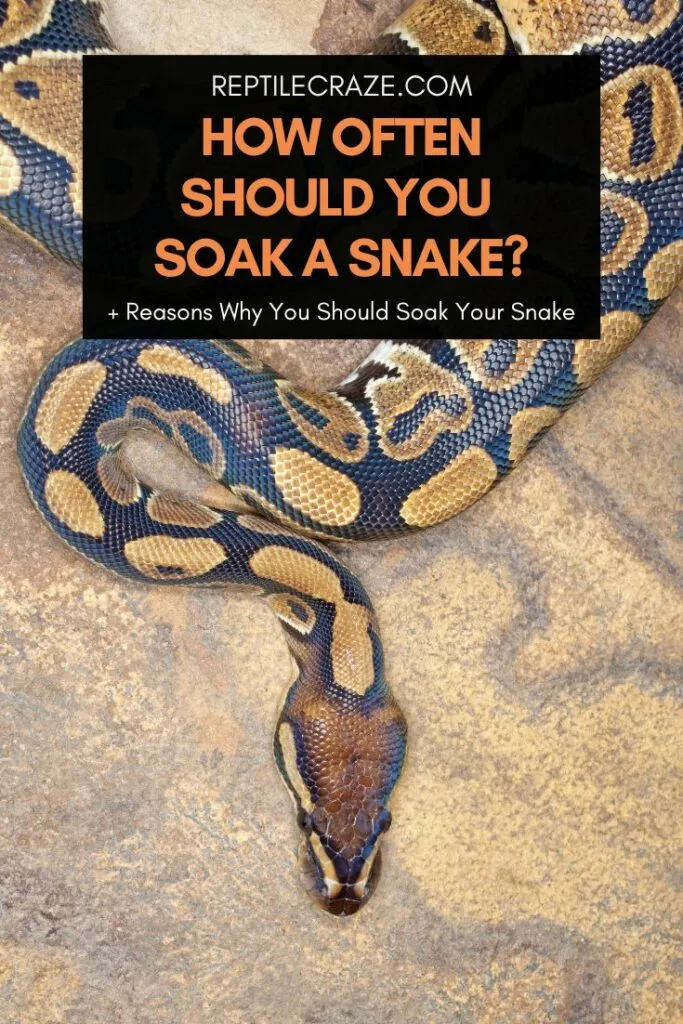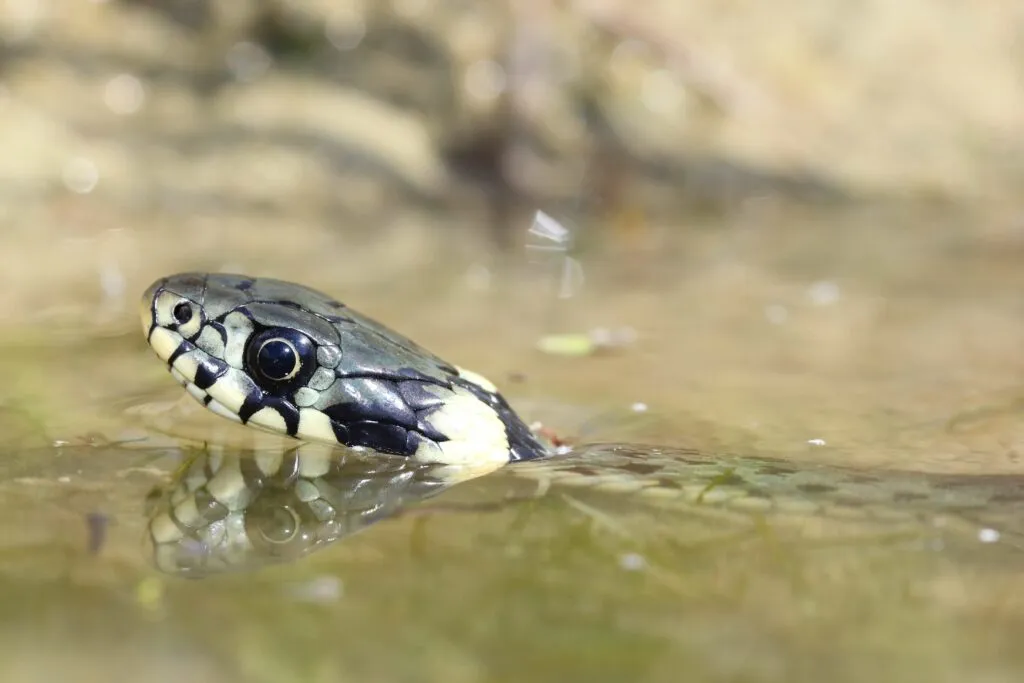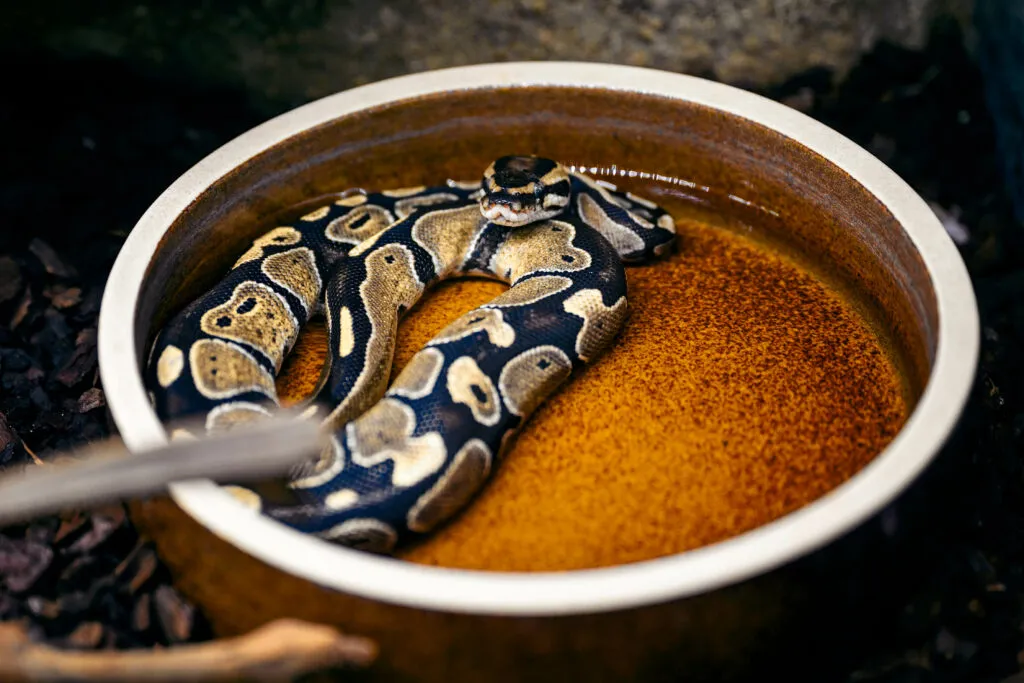
Should you give your snakes a soak or a bath? If your snakes do need a soak, how should you soak them? Are there snakes that like to take a bath? It is confusing to decide on the matter especially when you see your dirty snake. Will a soak benefit your snake?
You should only soak your snake when the situation calls for it. Unlike other animals, they do not need to have a bath habitually. You should only soak your snake if it has a poor bowel movement, is dehydrated, has a stuck shed, mites infestation, and if it is extremely dirty.
In this article, we are going to discuss the situations where soaking your snake proves to be beneficial to them. At the same time, we will go over the steps to take to properly soak your snake while minimizing stress. So keep on reading to find out!
Table of Contents
Reasons Why You Should Soak Your Snake
Snakes do not need to be soaked or given a bath. Having a water bowl in their enclosure is sufficient for your snake to drink or even soak into when it requires.
Some snakes just drink from their water bowl, while others soak for a bit as part of thermoregulation and rehydration.
However, there are instances where you really need to take out your snake from its enclosure and manually give it a soak. Keep in mind that these reasons are exhaustive.
Therefore, reasons outside of the ones enumerated do not merit a soaking for your snake.
If you just want to soak your snake just for the heck of it, you risk stressing your snake or even drowning it if you do not follow the appropriate steps. Rule of thumb: Do not soak your snakes unless you really need to.
1. Your Snake Is Dehydrated
Snakes are cold-blooded reptiles that require thermoregulation. In order to be warm, they need to stay in the warm area of the enclosure, and when they need to cool off, they stay in the cool area.
There are cases when the temperature inside the enclosure gets too high. This is the case when the temperature outside of the enclosure goes up (during summer) and even the temperature inside of the enclosure is affected.
The same goes for when there are problems with the heat settings of the enclosure. When this happens, it is no longer enough for your snake to stay in the cool area. Snakes will immediately find a water source to soak in to remain cool.
This is the reason why some snakes can be found sleeping in their water bowls. Usually, it is a temperature issue. If the high-temperature problem is not corrected immediately, your snake will become dehydrated. No amount of misting the enclosure can revert the damage.
Therefore, you must rehydrate your snake by soaking it in a tub or container. In this way, it can rehydrate its body and also drink its fill of water. Breeders who have dehydrated snakes usually soak the snakes first before they go to the vet.

2. Snake Has Poor Bowel Movement
There are instances when your snake has a poor bowel movement. This does not necessarily mean that it is impacted, it simply means that it is having trouble relieving itself.
You can help your snake by giving it a little soak. Just keep in mind to put your snake in a larger tub when your purpose is to help it poop.
In this way, the snake can move around and its undulating movements paired with the warm water will help encourage your snake to poop.
3. Snake Has Stuck Shed
We all know that we should just leave our snakes alone in their shed. However, there are cases when your snake has a stuck shed that it cannot remove on its own no matter how hard they try to bump against things in the enclosure.
Leaving a stuck shed on a snake can make your snake uncomfortable and eventually stressed. This is where soaking it is a good idea. The water will loosen the stuck shed so that you can gently pull it off your snake.
4. Snake Has Mites
It is crucial to immediately deal with a mite infestation in your snake’s enclosure as well as your snake. Mites can be difficult to see on your snake as they just appear as tiny black dots that resemble the color and pattern of your snake.
However, mites can be dangerous to your snake as they can cause infections. In some cases where the mites were belatedly discovered, it can cause your snake to be malnourished or even lead to death.
In order to be rid of these mites, you should soak your snake as the heat from the water will suffocate the mites. You can also opt to soak it with additives (betadine/povidone-iodine) to treat the wounds.
5. Snake Is Extremely Dirty
You should not soak your snake when you see that a bit of substrate is hanging on its body or if it has muddy scales. A snake that has become dirty due to day-to-day activities in the enclosure is perfectly fine and does not need to have a soak.
In such a case where the snake is extremely filthy like when it has poop smeared all over its body and the substrate is already clinging to its body, then it is time to give it a soak.
Leaving fresh or old poop on the snake’s body can damage its scales and will also leave your snake prone to bacteria. Further, it can promote the growth of mites.
How To Properly Soak A Snake

If your snake fits the following reasons stated above, then it surely calls for a soak that will be beneficial to it. Keep in mind that this endeavor will definitely stress your snake, but it is our job to make it as less stressful as possible.
Here are the steps:
- Get a bowl or a container
- Fill in enough water so that your snake can fully submerge in it
- Make sure the water has around 85 °F
- Add an object the snake can grip to the container
- The soak should last for around 15 minutes
Let’s have a look at that in detail:
Secure a container where your snake will soak. You should drill holes into it so that air can still get inside the container.
It is best if the container comes with a locked lid as your snake will try to get out of the tub. The size should not be too small to squish your snake, but not large enough to make your snake feel that it is overexposed.
The water should be deep enough to barely cover the back of your snake. In this way, the snake can still rest its body on the bottom of the container without the potential of drowning. If your snake is floating on the water, it will become stressed.
The water should be around 80-85 °F. You should start soaking your snake when the temperature is warmer as the water will cool down eventually. In this way, when your snake is done soaking the water temperature is still within acceptable bounds.
Put an object inside the container where the snake can grip on. This can be a big rock or a hide. This can help calm your snake.
Put in your snake and close the lid. It is better to put a blanket on the container to lessen the stress on your snake.
The soak should last for 15-20 minutes. During this time the water temperature will also start to cool down to 80 F.
After 15-20 minutes, you can then add your additives to the water (if needed) The reason for adding it after the initial soak is that the snake may drink the water, so if the additives were already in the water pre-soak they may ingest the chemical.
If you added additives, you can leave your snake to soak for another minute before taking it out.
Important Reminder: The water should not be too cold as it may cause a respiratory infection. It should also not be too hot as it can cause permanent neurological issues and may even cause death.
Keep in mind that if you plan to soak your snake, you should soak it at least two days after a meal. This is done to ensure that your snake will not regurgitate its meal due to stress.
Common Pet Snakes And How To Soak Them
| Type of Snake | Soaking Method |
| Milk Snake | Hates to be manually soaked. Best to put a large water bowl in the enclosure to let them soak by themselves. |
| Corn Snake | Enjoys being in the water. Automatically soaks in the water bowl and is less stressed with manual soaking. |
| Red-tailed Boa | Loves to soak. Prefers to soak in a large water bowl. Can also be manually soaked. You should use a larger tub with a locked lid. |
| California King Snake | Soaks in their water bowl just to cool off. Can be highly stressed when manually soaked. Be careful when putting them in the container as they will immediately try to escape. |
| Green Tree Python | Does not need to soak. Misting the snake and its enclosure is enough. Only soak if it has mites on it. |
| Rosy Boa | Does not like too much water. Does not even soak in its water bowl unless needed. Manually soaking it will stress it too much. If there are mites, you can opt to spray it with warm water inside its enclosure to suffocate the mites. |
| Gopher Snake | Prefers a dryer environment so it does not soak in its water bowl. Can be manually soaked, but they usually cannot soak by themselves as they try to get away from the water and just stay on top of the rock or hide. If you are treating mites, you should manually wipe the water on its body. |
| Western Hognose Snake | Dangerous to leave it soaking. As they turn themselves upside down due to stress, they risk drowning. Keep a close eye on them during soaking. |
| Rat Snake | Loves to soak in their water bowl and is also more open to manual soaking. |
| Garter Snake | They love the water and will automatically soak in their water bowl especially when they are nearing their shed. They will try to escape during manual soaking. |
| Ball Python | Loves to soak in water and will even sleep in their water bowls. Also prone to poor bowel movement so manual soaking is required. |
| Reticulated Python | As it is a bigger snake, soaking in the water bowl may not be sufficient. Also prone to poor bowel movement so it is best to soak it in a larger tub or even a bathtub. |
| Bull Snake | Does not usually soak in the water bowl. Only needs to be manually soaked if it has a stuck shed, poor bowel movement, or mites infestation. |
| Egg Eating Snake | Prefers high humidity levels and love to soak in their water bowls. No need to manually soak except for mites infestation. If they were not able to regurgitate the eggshell, they can be soaked to encourage regurgitation. |
| Burmese Python | Loves the water and they love to swim. You should soak in a large tub, bathtub, or small pool. |
| Dekay’s Brown Snake | Does not soak in the water bowl too much. Not recommended to do manual soaking as they have a high risk of drowning. If it needs to be soaked, you need to supervise it or even handle it while soaking. |
| Kenyan Sand Boa | Prefers to soak in the water bowl. Does not encounter a lot of issues that require manual soaking, except for mites infestation. |
| Ringneck Snake | Sometimes soak in their water bowl but prefers to get moisture from the wet substrate. Only do manual soaking if needed. |
| Carpet Python | Soaks in the water bowl if it needs to. Does not usually need manual soaking. |
| Children’s Python | Likes to soak in the water bowl especially when they are about to shed. Calmer when doing manual soaking, but will still try to escape. |
Final Words
Only soak your snake if it needs to be soaked. If there are no underlying problems with your snake that require a soak, then it is best to leave it alone to soak by itself in its water bowl.
Manually soaking a snake (even if it loves the water) will cause stress to it. Therefore, you should make sure that the water temperature is right and that your snake has something to cling to during the soak.
Doing these will help calm your snake during this stressful endeavor.
- Enchi Ball Python: A Unique and Stunning Morph of Python regius - March 27, 2025
- Emerald Tree Monitor: The Enigmatic Green Guardian of the Rainforest - March 26, 2025
- The Egyptian Cobra (Naja haje): A Fascinating Serpent - March 25, 2025
